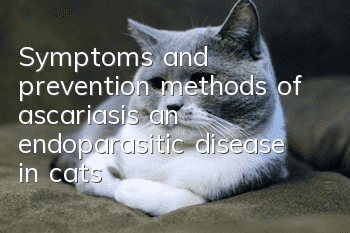Symptoms and prevention methods of ascariasis, an endoparasitic disease in cats

Ascariasis is a zoonotic disease. This worm mainly lives in the small intestine of cats, and the worms are relatively long. The disease is mainly caused by the owners not deworming the cats regularly and the cats living in a poor sanitary environment.
1. Pathogens and Transmission
There are many types of roundworms, and each has its own specific host for infection. Cat roundworms are about 5 to 10 centimeters long, slender and have sharp ends. The life history of roundworms is quite special. After the female lays eggs, the eggs will be excreted out of the body with the feces. Five days later, larvae will form in the eggs. When the eggs are swallowed by a cat, they will hatch in the small intestine and enter the intestines one hour later. The blood vessels of the tract are transferred to the lungs, liver and other organs with the blood. The larvae that grow up in the lungs will crawl from the respiratory tract to the throat and be swallowed to the small intestine again. After 20 to 30 days, they will develop into adults and lay eggs again 60 days later. , begins another life history; this development method is the so-called internal migration life history. In addition to oral infection, cat roundworms can also be transmitted to kittens through breast milk. If canine roundworms are ingested by pregnant female cats, they can also be transmitted to the fetus through the placenta.
2. Symptoms
Cat roundworms cause damage in two aspects. First, the parasitism of adult worms can cause malnutrition in cats: kittens infected with cat roundworms, even if the number is not large, will still have rough hair, vomiting, pale gums, thin and bulging abdomen, etc. Clinical symptoms: Obvious symptoms will only appear when adult cats are infected with a large number of worms, and sometimes worms can be spit out from the mouth. If there are too many roundworms, it can even cause intestinal obstruction or even rupture. During the migration of larvae, it may also cause liver bleeding, cholangitis, intestinal perforation and peritonitis, etc.
3. Prevention
Pay more attention to the health of your cat and pay attention to the cleanliness of food and environment. Cats kept at home should undergo regular fecal examinations twice a year; cats that roam freely outdoors must be examined 3 to 4 times a year for early detection and early treatment. And follow the instructions of the veterinarian and give appropriate anthelmintics regularly.
- Will kittens grow up after their eyes are small?
- How often should kittens be vaccinated and dewormed?
- How to train a cat to make graceful postures? Cat skill training!
- Why do cats always knock things over?
- How much catnip can cause death if a cat sucks it?
- Both parents have erect ears, so why do kittens have folded ears?
- How to prevent rickets in cats with folded ears
- Why does the cat keep meowing at six or seven in the morning?
- Four steps to stop your cat from scratching furniture!
- How to tell if a Birman cat is pregnant



